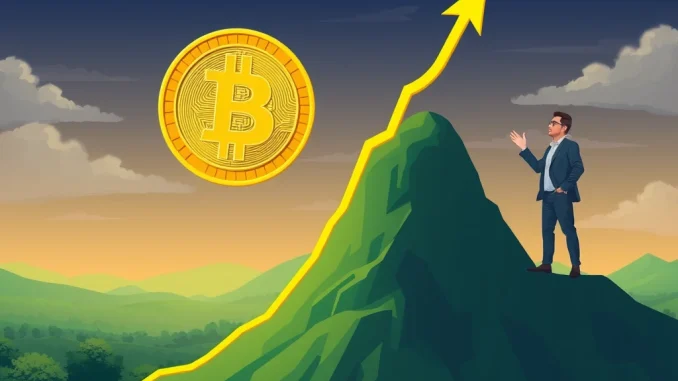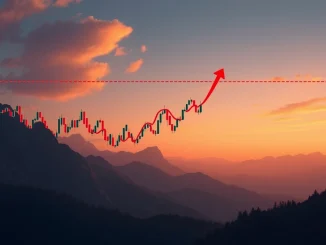
The cryptocurrency world recently witnessed a significant milestone: the Bitcoin price soaring past the psychological barrier of $100,000. This event, while exciting for many, also brings with it the familiar waves of market emotion. Amidst this surge, Binance founder CZ Bitcoin offered a piece of timeless, yet often overlooked, Bitcoin advice via social media platform X: “Bitcoin is easy, just don’t panic sell.” This simple statement, made as BTC traded around $100,867 according to CoinMarketCap data, cuts directly to the core challenge faced by investors navigating the often-turbulent waters of the crypto market. But why is this advice so crucial, and why is it so hard for many to follow?
Why is Panic Selling Crypto Such a Powerful Urge?
The phrase “don’t panic sell” sounds straightforward, yet resisting the urge to sell during sharp market downturns (or even during rapid pumps driven by fear of missing out) is incredibly difficult for many investors. This behavior, known as panic selling crypto, is primarily driven by powerful psychological forces: fear and greed.
- Fear: The fear of losing capital is perhaps the strongest driver of panic selling. When prices drop significantly, the instinct is to sell immediately to prevent further losses, often resulting in selling at the lowest points.
- Greed: While less obvious, greed can also lead to hasty decisions. Seeing prices skyrocket can trigger the fear of missing out (FOMO), pushing investors to buy at peaks, or conversely, the urge to sell too early to lock in profits, only to watch the price continue to climb.
These emotions are amplified by the Bitcoin market volatility, making rational decision-making under pressure a significant challenge.
Navigating the Swings: Understanding Bitcoin Market Volatility
One fundamental aspect of investing in cryptocurrencies, especially Bitcoin, is accepting its inherent volatility. Price swings of 10%, 20%, or even more in a single day or week are not uncommon. Understanding this is key to avoiding panic. Historical data shows that Bitcoin has experienced numerous significant price corrections and even prolonged bear markets, only to recover and reach new all-time highs eventually. This cyclical nature is part of the asset’s journey. Long-term holders (often referred to as ‘HODLers’) who resist the urge to sell during dips have historically been rewarded, but this strategy requires conviction and the ability to stomach significant paper losses.
CZ Bitcoin‘s Perspective: Experience and Simplicity
Coming from someone who has been at the forefront of the crypto industry’s growth for years, CZ Bitcoin‘s advice carries weight. His perspective is shaped by witnessing countless market cycles, bubbles, crashes, and recoveries. His simple guidance reflects a long-term view – one that prioritizes staying invested through the inevitable ups and downs rather than attempting to time the market perfectly, a feat that is notoriously difficult, even for seasoned professionals.
Actionable Bitcoin Advice: How to Avoid the Panic Trap
So, beyond just hearing “don’t panic sell,” what practical steps can investors take to follow this crucial Bitcoin advice and manage their emotions during periods of intense Bitcoin market volatility or rapid changes in Bitcoin price? Here are a few actionable insights:
- Develop a Strategy BEFORE Investing: Know your investment goals, time horizon (short-term gain vs. long-term growth), and risk tolerance. Decide on entry and exit points or a holding strategy beforehand, rather than making impulsive decisions based on real-time price movements.
- Invest Only What You Can Afford to Lose: This golden rule of crypto investing cannot be stressed enough. If the money invested is essential for immediate needs, any significant price drop will naturally trigger panic. Using disposable income allows for a more rational, long-term perspective.
- Think Long-Term (HODL): If you believe in the fundamental technology and potential of Bitcoin, focus on the long game. Short-term price fluctuations become less significant when viewed over years or decades.
- Diversify (Wisely): While Bitcoin may be a core holding, consider diversifying across different asset classes (not just other cryptocurrencies) to manage overall portfolio risk.
- Limit Checking Prices Constantly: Excessive monitoring of charts can heighten anxiety and lead to emotional decisions. Set specific times to check your portfolio if necessary.
- Educate Yourself: Understanding the technology, market dynamics, and macroeconomic factors influencing crypto can help build conviction and reduce fear based on speculation.
Beyond the $100K Bitcoin Price: Focusing on the Long Game
While hitting $100,000 is a remarkable milestone for the Bitcoin price, it’s just another point on a potentially much longer trajectory. Fixating solely on this number or the day-to-day fluctuations can obscure the bigger picture. CZ Bitcoin‘s advice reminds us that success in volatile markets often comes down to discipline and patience, not perfect timing or emotional reactions.
[Insert potential table here comparing HODLing vs. Panic Selling outcomes in a hypothetical scenario during a past dip/recovery]
[Insert potential image tag here if available]
[Insert potential caption shortcode here if available]
Conclusion: The Power of Patience in a Volatile Market
As Bitcoin price continues its journey, likely experiencing more periods of significant Bitcoin market volatility, the simple Bitcoin advice from CZ Bitcoin – “just don’t panic sell” – remains incredibly relevant. Resisting the urge to engage in panic selling crypto requires discipline, a long-term perspective, and emotional control. By understanding the psychological traps and implementing practical strategies, investors can better navigate the market’s swings and potentially benefit from Bitcoin’s long-term growth trajectory. In the world of crypto, sometimes the simplest advice is the hardest to follow, but often the most rewarding.



